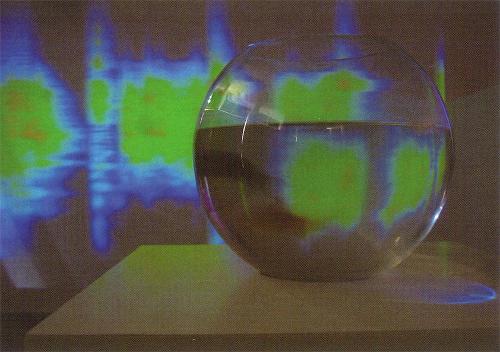
To begin with suggests the first line of a story. It signals the moment of pause before a tale is spun, a moment to take a breath before we are plunged into a knotted mass of quirky characters, familiar scenarios, odd references and convoluted ideas which are untangled and woven together. The works in this exhibition, curated by Richard Wastell, offer snippets of disparate narratives in which things are not quite what they first appear to be and stories which allude to peculiar engagements with nature.
Amanda Davies' diptych titled Plastic Plant & Plastic Plant 1 is a profusion of artificial tropical foliage meticulously painted in oil on canvas and enamel on plastic from a photograph. Davies has depicted fluoro-lit facades and prosaic objects which are invariably found in public places such as library foyers, casino lobbies, offices and museum corridors. Catching our cursory glance, Davies' paintings insist we linger in these neutral zones - the placid backdrops to daily comings and goings. Despite the verisimilitude of the images and the inertia and passivity of the objects, these paintings have a weird quality: an orange public pay-phone is mounted on a utilitarian wall of pine panelling; a fire extinguisher reflects the lights of poker machines; a feeble pot-plant sits on a window ledge in a nondescript air-conditioned office space. There is no tension, rather the untold stories of strangers and an empty sense of transience.
Slagheaps and pools of muddy water resonate with the heroic narratives of Romanticism in Martin Walch's black and white photographs. These images both reference and up-end the grand vistas of Romantic landscape photographers such as Anselm Adams and Peter Dombrovskis. Depicting abandoned mine shafts, gouges and chasms from open-cut mining and heaps of tailings, they simultaneously allude to human struggle, obstinacy and aspirations and document the devastated landscape around the Mt Lyell mine at Queenstown, Western Tasmania. Strangely, despite the defoliated mountains and the evidence of gross disfigurement they are at once harrowing and powerfully beautiful.
Hermie Cornelisse's eccentric series of hand-built ceramic vessels collectively titled Reservoirs are the result of conjuring up fragments of stories and memories from a time when, as a young woman, she lived and worked at Zeehan. Wastell notes that 'abandoned mine shafts became symbolic monuments to her life and situation there.' Perhaps softened by the haze of time, the milky blue and ochre-coloured glazed pieces with decorative geometric friezes have the irregular, soft angular shapes of fenced wells, pits and hewn rock.

Aberrant and skewed physical features of the body are emphasised in Annika Koops' formal portraits of young women. Her paintings depicting girls on the brink of womanhood dream their life stories into existence and toy with their identities, flaunting imperfections and idiosyncrasies such as a lazy eye, asymmetrical features, birthmarks and tattoos with the fascination of a fetishist or a voyeur, challenging our notions of beauty. In Freckled girl in pearls Koops has painted an adolescent girl, posing like a lady and gazing introspectively as if into a mirror. In the cloistered confines of a darkened interior she wears a brazen red dress pushed off timid shoulders and dandles a string of pearls with a gloved hand. A twisted beauty, her imperfections, so nearly repellent, are entrancing and weirdly haunting.
Matt Newton has intruded into the private domain of shacks and photographed the bizarre collections of objects, second-hand crockery, and odd pieces of furniture which accumulate in them, in order to expose and celebrate a unique aspect of Tasmanian culture. Wastell notes that 'by meeting the local personalities and hearing their stories, by gaining access to their private obsessions and loves, Matt makes the world larger for himself&he makes the world larger for us all.' Invariably located on the coast or along the edges of inland lakes and rivers, Tasmanian shacks are physical manifestations of the desire to engage with nature and the escapist dreams of those that frequent them. In Large carved fish, a large salmon crudely carved from a lump of wood - perhaps an old fence post - is strung from the front verandah post of a shack like an ancient religious totem.
To begin with, like all the best stories, leaves one with the desire for more.












